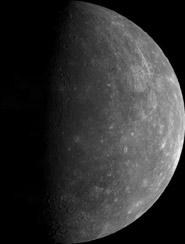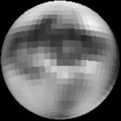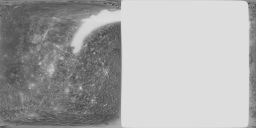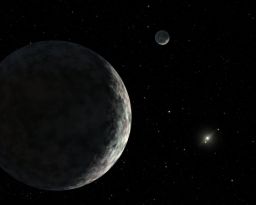Emily Lakdawalla • Jan 25, 2008
Back-of-the-envelope calculations on Mercury
I've had cause to consider two different sets of "back-of-the-envelope" calculations for Mercury today. "Back-of-the-envelope" is a term used by scientists to mean calculations performed quickly, usually involving approximations, to estimate a number roughly, the kind of calculation you can write down quickly with pencil and paper, not using your calculator. Kids these days don't know how to do back-of-the-envelope calculations. I once taught fifth and sixth grade science, and my otherwise smart students used to pull out their calculators when they needed to multiply or divide by ten. Ten! It's always a wise choice to do back-of-the-envelope calculations first, so you can tell if you accidentally bang multiple buttons on your calculator and wind up with a wildly wrong answer. And if you gauge your estimations right, rounding up sometimes and down other times, you can get amazingly close to the actual values.
So, Mercury is 4,878 kilometers in diameter. Call it 5 thousand. Pi is about 3, so the surface area is about 3 times 5 times 5 times a million, or 75 million square kilometers. Mariner 10 imaged slightly less than half of that, so the un-imaged area is a little more than half of that, so call it 40 million square kilometers.
OK, so let's run with Eris. Eris' unseen surface is about 3 times 2.4 times 2.4 times a million. 2.4 squared is harder to estimate, but you know that 2 squared is 4, and 3 squared is 9; 2.4 squared should be closer to 4 than 9, so call it 6; so that gives me 18 million square kilometers for Eris' surface area.
If you want to be a weenie you can work this out with a calculator and you'll get basically the same result. In other words, Mercury's unseen surface area, 40 M-km2 is more than twice as big as the unseen surface area of Eris, 18 M-km2, the next biggest unseen area in the solar system. Here's the kicker: on this flyby MESSENGER revealed slightly less than half of the as-yet-unseen area of Mercury. That means that even with the first MESSENGER flyby complete, Mercury still has the largest area never seen by spacecraft of any solid body that we've discovered in our solar system.
 Mercury |  Pluto |  Miranda - Ariel - Umbriel   itania - Oberon |
| All these bodies are shown at a scale of 20 km per pixel. Half of Mercury hadn't been seen before MESSENGER's flyby. None of Pluto has been seen up close, and neither has Eris, which is similar-sized; and half of all those Uranian moons are also terra incognita. | ||
The other back-of-the-envelope calculation has to do with whether an astronaut would need sunglasses at Mercury. A reader wrote me to complain about the absence of "true color" images released from the MESSENGER flyby, saying he wanted to see what an astronaut would see. That made me wonder whether an astronaut would actually be able to look at Mercury's surface with unshielded eyes (unshielded by anything other than the faceplate of her pressure suit or the window of her spacecraft, of course). I mentioned this in an email chat I was having with Chuck Magee; you can go see his back-of-the-envelope calculations at Lounge of the Lab Lemming. The punch line is that Mercury wouldn't be bright enough to fry an astronaut's eyes, but prolonged staring at its surface could cause "snowblindness."
This would be exacerbated by the utter blackness of the sky -- your eyes would have no way of handling the extreme contrast. Apparently, for this reason, the Apollo astronauts often chose to use sunglasses, and when Apollo 16 astronaut John Young didn't put his on for the ascent from the Moon, he wound up riding into orbit in an almost completely sun-blinded condition. (So space enthusiast Doug Vandorn tells us.)
As for getting "true color" images of Mercury, MESSENGER's wide-angle camera does have the filters necessary to approximate the colors that a human eye would see, but making views that look like what human eyes might see takes very, very, very careful calibration of the data. (I've written about this before.) These being the first images back from MESSENGER at Mercury, you're all going to have to exert a little patience; it may be a long time before the camera has been calibrated well enough to figure out exactly how to combine those filtered images to produce colors akin to what we'd perceive if we were there.
Support our core enterprises
Your support powers our mission to explore worlds, find life, and defend Earth. You make all the difference when you make a gift. Give today!
Donate

 Explore Worlds
Explore Worlds Find Life
Find Life Defend Earth
Defend Earth



